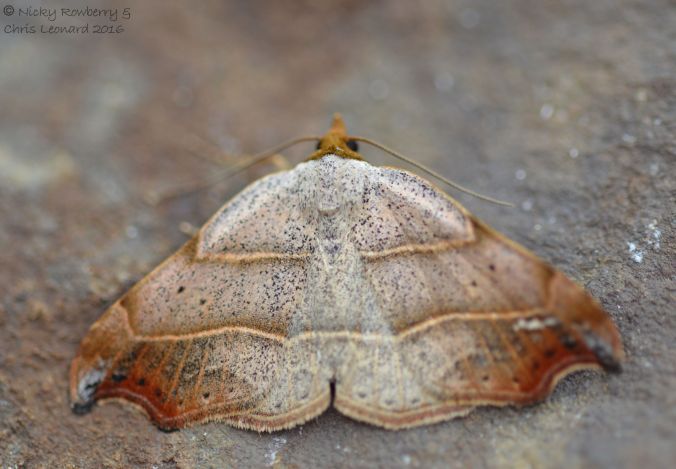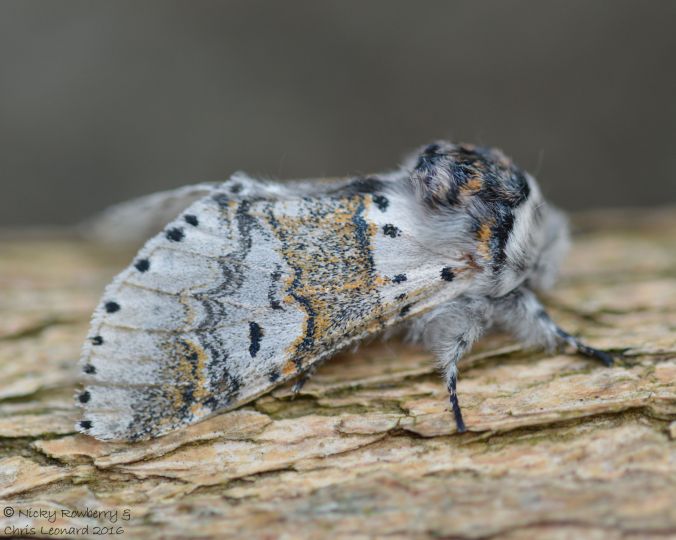It’s the end of the second quarter for the Garden Moth Scheme (GMS), so I thought I’d review some of the mothy highlights from the last couple of months. I trap once a week for the GMS but also occasionally trap on other nights too and last weekend tried trapping at my Dad’s house in Herefordshire for a change – so the photos below are from a mixture of all three. The first quarter of the GMS was dominated by the fairly plain Quaker type moths, so I’ll make no excuse for deliberately picking the more colourful and exciting moths (yes I do find moths exciting!) for this selection! Having said that I’ve just realised I’m starting with a grey one – but it is a particularly cute grey one!
These first three photos are all part of the Ermine group of moths, although the top ones are actually called Muslin Moths. These are grey male Muslins – the females being white. We seem to get a lot more of the males than the females in our garden for some reason.
This next one is I think a White Ermine although it could just be a female Muslin moth which are very similar. The White Ermines are so named because they look a bit like the fur that used to be used to trim rich people’s clothes (I’ve got an image now of Henry VIII covered in White Ermine moths!)
The final one of this little trio is a Buff Ermine – making beige look good.
The next four I’ve only grouped together on the basis of how beautiful they are. The first is even called the Beautiful Hook Tip!
The next is a Pine Beauty – a stunningly patterned small moth.
The next two may not have beautiful names, but they could rival any butterfly for its stunning colours. The Brimstone is named because it is yellow like sulphur.
The Scarlet Tiger is simply stunning and flies by day as well as by night – this one we caught in the moth trap, but on occasion we’ve seen a small flock of them flying in the afternoon.
The next one is a Peppered Moth – I’ve included this as it reminds me of biology lessons at school on the power of natural selection. The Peppered Moths are famous for the swing in the population’s colour during the Industrial Revolution when the whiter forms like this one, stood out against the trees blackened by soot and were therefore easy pickings for birds. The darker forms were better camouflaged at this time and so had higher survival rates and so came to dominate the populations. Since environmental standards have improved, there’s less soot and the white forms are once again the more common. We only ever seem to get the whiter ones in our garden – guess we’re soot-free!
The next few, I’ve chosen simply because of their interesting adaptations to avoiding being eaten. This Buff Tip manages to look remarkably like a broken twig. It matches even better on a Silver Birch twig, but this apple stick was the best I could do. If they keep still on the Birch, they must be virtually impossible to detect.
This Scorched Wing uses its colouration to avoid looking like a moth at all. The fading lines are supposed to break up its outline to make it harder to detect. No idea why it sticks its bum in the air though?
This Spectacle is one of my favourites. For a start it is very easy to identify – no other moth has a pair of specs on its head like this and secondly I find it adorable. It’s possible these “specs” are used to startle birds by looking like a large pair of eyes – several other moth and butterfly species use eye-like markings to shock birds, but as far as I know none of them look quite like this!
The Shark moth I chose really just so I can claim we have sharks in the garden! I think it’s the triangular pointy head that gives it the name. I’ve been wanting to find one for years, so was really chuffed to spot this in the trap in June.
The next two I’ve included partly because I like their names – Puss Moth (top) and Sallow Kitten (bottom). I’ve always assumed they were called Puss and Kitten because of their furry legs. I also like the way they have a tendency to sit with their front legs stretched out ahead of them – again a bit like a cat does.
And finally for this update the Hawk-moths. The biggest most spectacular moths we get in the UK. I’ve seen 4 species over the last couple of months, 3 in our garden and one at my Dad’s place. The first two are the ever-popular Elephant Hawk-moth (left) and Small Elephant Hawk-moth (right). It still amazes me that they are even real – they have bright pink bodies and just seem like a moth a child would draw if left with a load of bright pink crayons!
The next one is a Poplar Hawk-moth which is even bigger than the Elephants above. It always holds its wings at this awkward looking angle and flies in quite an ungainly way.
The final one is an Eyed Hawk-moth – we have had them in our own garden, but so far this year we’ve only seen this species at my Dad’s in Herefordshire. They have these bright “eyes” on the hindwings which they flash when disturbed to try and scare off predators.
So those are some of my mothy highlights from the last couple of months. Apologies to those species that I’ve not included – it would have been a very long blog post if I’d rambled on about them all – we’re up to 108 species for the garden already this year. But I do love them all – each new species that we find is a treasure and it’s wonderful to know just how diverse the moth fauna is in our garden.

















Fantastic post. I haven’t seen any of these moths in the city. Must be wonderful to see them though, one day maybe… 🙂
LikeLike
You’d probably be surprised at how many of these you’d get in your own garden if you put out a moth trap. I would never have guessed a few years ago how many we’d get. Perhaps you could borrow a trap from your local wildlife trust or similar group? Or go on an organised moth night? I’m sure you’d love it.
LikeLiked by 1 person
Such beautiful under appreciated creatures!
LikeLiked by 1 person